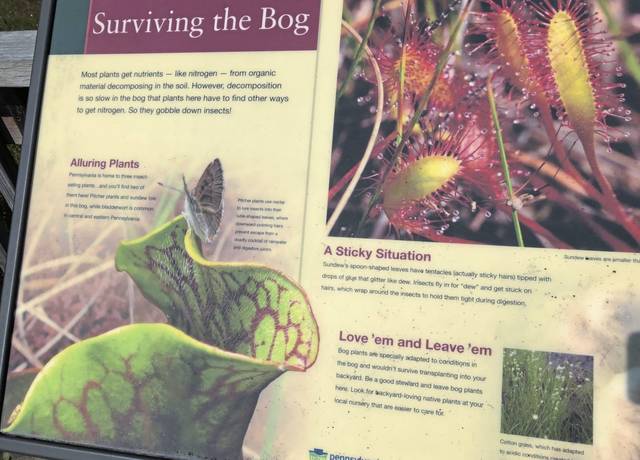https://triblive.com/local/westmoreland/spruce-flats-bog-plant-species-include-2-insect-eaters/
Spruce Flats Bog plant species include 2 insect-eaters

The soil in a bog consists largely of slowly decaying plant matter. Along with being acidic, it is oxygen- and nutrient-poor, limiting the types of plants that will thrive there.
Sphagnum moss provides the living plant layer atop the waterlogged environment.
Other common bog plants include reeds, sedges, cranberries, blueberries and huckleberries.
Some particularly interesting plants have met the challenges of finding sustenance in the bog by adapting to absorb nutrients from insect prey. These include the pitcher plant and sundew.
Here is a quick look at the insect-eaters and and a couple of other plants plentiful in Spruce Flats Bog.
• Pitcher plants use the pitfall trap method to capture insect prey. Their specialized leaves have adapted to form a deep cavity (resembling a pitcher) filled with nectar that attracts the prey, typically a small crawling or flying insect.
The rim of the pitcher is slippery when moistened by condensation or nectar, causing insects that light on it to fall into the trap. The insect drowns, and its body is slowly dissolved by the plant’s digestive enzymes, providing mineral nutrition — particularly nitrogen and phosphorus.
Shirley McMarlin | Tribune-Review Insect-eating pitcher plant in Spruce Flats Bog in Forbes State Forest.• Sundew plants have numerous tentacle-like structures radiating from a base, topped with sticky hairlike glands. When an insect comes in contact with the tentacle, it bends inward to bring the insect into contact with as many stalked glands as possible. This is called a flypaper or trigger trap.
The plant secretes enzymes that dissolve the insect, freeing the nutrients it contains. The nutrient mixture is then absorbed through the leaf surfaces.
Shirley McMarlin | Tribune-Review Top: Insect-eating sundew plants dwell in Spruce Flats Bog in Forbes State Forest. Above: An insect-eating pitcher plant awaits its prey.• Cottongrass is a flowering grass of the sedge family. Found in bogs throughout North America, it is particularly abundant in regions of Arctic tundra. The cotton-like fibers of its flowers have been used to make paper, candle wicks and stuffing for pillows. The leaves were once used to treat diarrhea, and the pith of the stem for removing tapeworms.
Shirley McMarlin | Tribune-Review Cotton grass at Spruce Flats Bog in Forbes State Forest.• Cranberries are low, creeping evergreen shrubs or vines found in bog habitats throughout the northern hemisphere. While they can be found in Spruce Flats Bog, they are less numerous than many of the other resident plant species.
Don’t visit the bog thinking you’ll harvest enough for your Thanksgiving sauce, says Rachael Mahony, Forbes State Forest environmental education specialist — they’re quickly devoured by resident birds and wildlife.
Shirley McMarlin | Tribune-Review Cranberry plant at Spruce Flats Bog in Forbes State Forest.Copyright ©2025— Trib Total Media, LLC (TribLIVE.com)
